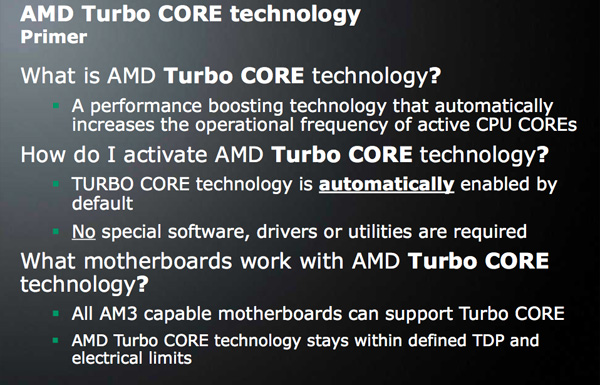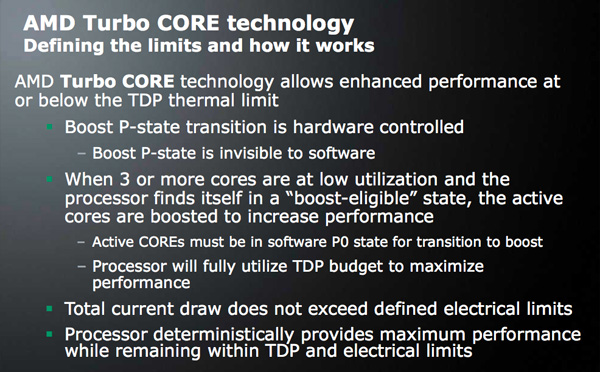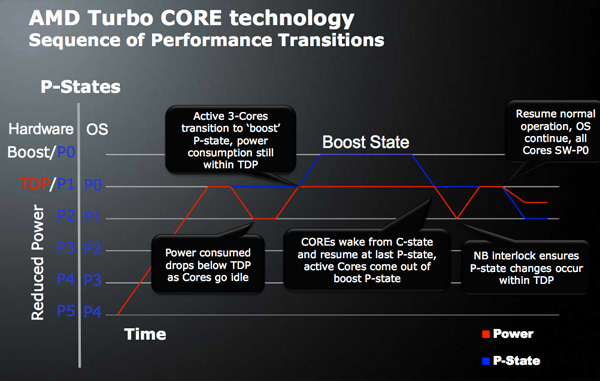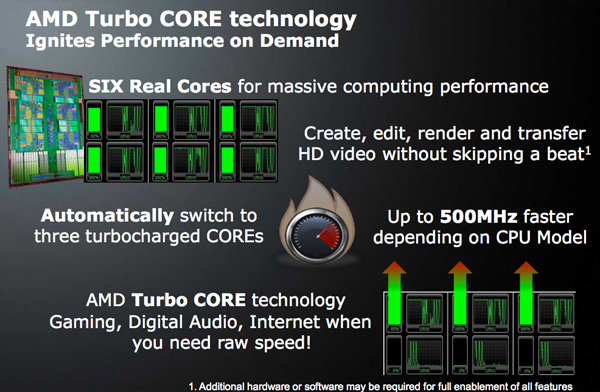AMD Divulges Phenom II X6 Secrets, Turbo Core Enabled
by Anand Lal Shimpi on April 8, 2010 12:00 AM ESTLast month Intel introduced its first desktop 6-core CPU, the 32nm Gulftown Core i7 980X. Running at 3.33GHz we loved the fact that it’s quite possibly the first Extreme Edition part that is able to justify its price. For $999 you get six cores and better performance all in the same power envelope as the current high end quad-core i7s.
The 980X is a great chip, but spending $999 on a single component in your PC is a tough sell for most folks. Luckily, AMD is coming out with its own 6-core processors codenamed Thuban. Below is what we know so far about AMD's Thuban lineup (note, the information in the table was not provided by AMD):
| AMD 2010 Roadmap | |||||||
| CPU | Clock Speed | Max Turbo (<= 3 cores) | L3 Cache | TDP | Release | ||
| AMD Phenom II X6 1090T | 3.2GHz | 3.6GHz | 6MB | 125W | Q2 | ||
| AMD Phenom II X6 1075T | 3.0GHz | 3.5GHz | 6MB | 125W | Q3 | ||
| AMD Phenom II X6 1055T | 2.8GHz | 3.3GHz | 6MB | 125W/95W | Q2 | ||
| AMD Phenom II X6 1035T | 2.6GHz | 3.1GHz | 6MB | 95W | Q2 | ||
| AMD Phenom II X4 960T | 3.0GHz | 3.4GHz | 6MB | 95W | Q2 | ||
Officially branded the Phenom II X6, AMD won’t be launching these processors until some time in the future. But today AMD is disclosing some basic details about the parts. We’re also mixing in our knowledge of internal AMD roadmaps to paint a clear picture of AMD’s 6-core strategy.
The more cores at the same TDP feature that Intel delivers with the 980X, AMD is also promising with Phenom II X6. The difference is that these are still 45nm parts. While we’ll have to test them to be sure, AMD currently indicates that the entire Phenom II X6 lineup will be rated at 95W or 125W TDPs. It’s all manufacturing tricks that make it possible (good job GlobalFoundries). In theory you should be able to buy a Phenom II X6 and have it operate in the same power envelope as a Phenom II X4 965.

With the Thuban cores AMD is introducing its version of Intel’s Turbo Boost technology called Turbo Core. AMD has yet to implement power gating on its processors, so Turbo Core works a little differently than Intel’s Turbo.
Turbo Core kicks in when 3 or more cores (on a 6-core part) are idle. When this happens, the frequency of those three cores is reduced to 800MHz, the voltage to the entire chip is increased, and the remaining three cores are turboed up by as much as 500MHz. It doesn’t get any more granular than this. If you have 3 or more cores idle, then the remaining turbo up. In any other situation the CPU runs at its normal clocks.

The CPU handles all monitoring and does the clock/voltage management itself. The switch to turbo up cores apparently happens fast enough to deal with Windows moving threads around from core to core.

Turbo core is triggered by a deterministic system that is based on load demand and current operating conditions (not temperature).
Cool’n’Quiet is active throughout the turbo process. What actually happens is that when CnQ looks to see if a set of cores should be downclocked, it also has the ability to increase the frequency of other cores.

This isn’t nearly as elegant of a solution as Intel’s turbo. The idle cores are never actually shut off, and voltage to all cores is increased to reach the higher clock speed. However if it works as advertised with no drawbacks (e.g. underclocking 3 cores when you actually still need them) then it’s definitely better than nothing for the Phenom II lineup. AMD will also have quad-core CPUs with turbo core support based on the new Thuban cores.
The great news? All Socket-AM3 and AM2+ motherboards will work with these new Phenom II X6 CPUs with nothing more than a BIOS update. The boards do have to support the TDPs the chips are rated for of course.
Pricing and performance are both unknowns at this point. We’ll keep you posted!










58 Comments
View All Comments
rickcain2320 - Thursday, April 8, 2010 - link
Anything less than Intel's exorbitant $999 I suspect, but here's hoping its $299 or less. I can't wait.frozentundra123456 - Thursday, April 8, 2010 - link
Glad to see that there are several chips in the line up instead of just a super high end like intel did.Hopefully the price of at least some of the models will make them practical for mainstream use.
Maybe this will force intel to release more hexa cores too.
Eeqmcsq - Thursday, April 8, 2010 - link
Good to see AMD bring the Turbo feature to their lineup. Can't wait to see these CPUs trickle down into even lower price segments later on.But moving forward, now both Intel and AMD will have variable clocked CPUs. Benchmarking and determining which CPU performs "better" will be even more complicated compared to constant clocked CPUS. On a variable clocked CPU, performance will actually drop when more tasks are being run due to the CPU clocking down from turbo, whereas on a constant clocked CPU, performance remains constant as long as there are cores available to complete the current tasks. Just more things to check for when picking a CPU.
Smoked Tails - Thursday, April 8, 2010 - link
It doesn't make evaluating and comparing any more difficult than it used to be. I remember back when reviewers had to double check the operating speeds of motherboards for reviews simply because some manufacturers would squeeze in a few extra MHz here and there.For this I can see tweaking the suite to include things to compare the performance of Intel's vs. AMD's implementations. But, I'd like to see the majority of testing with it off. That's just me being odd I guess. I think it's easier to quantify performance/watt or $ that way. Although, keeping the focus off of the turbo could potentially eliminate methods of benchmark tampering that ATi and Nvidia used to use. I'd hate to see a driver update that disabled two cores for Vantage so that you get 4 cores at 3.x GHz.
Anyways, just my two cents.
TranceCode - Thursday, April 8, 2010 - link
Could we have a comment button to 'mark spam' please?A way for the community to help remove comment spam would be a great feature.
JarredWalton - Thursday, April 8, 2010 - link
The admins have that feature, and when used three times on an account the account should be deactivated (as well as deleting the spam).silverblue - Thursday, April 8, 2010 - link
2 extra cores will help in situations where you can throw as many cores as you like at a task. We may also get to see what keeping the L3 cache at 6MB will mean for performance; probably very little unless AMD has tinkered around with the latencies (unlikely). I doubt it'll perform better at the same speed as a current X4 on a core-per-core basis.My concern lies with a) software that utilises exactly 4 cores, and b) the deviation from the power-of-2 system. It's entirely feasible that the Phenom II X4 965 BE will outperform AMD Phenom II X6 1090T in either of these situations due to its higher core speed plus the fact that the software won't scale up from 4 to 6 cores. For anything that doesn't tax all four cores of the 965 BE, or has no limit on the number of cores it can use, the 1075T and 1090T will generally win out. So, AMD have seemingly tackled both ends of the spectrum but due to the fact that the CPU itself doesn't have a number of speed bins for each number of active cores (like Nehalem), there's no middle ground because there's no graceful drop in speed when four or five cores are being taxed. 333 and 166MHz boosts for 4 and 5 cores respectively would've been better in my opinion, however perhaps AMD thinks that if an application uses all four cores on an X4, it will gratefully utilise the other two on an X6. We'll have to wait for the benchmarks to see if this was a good approach or not.
As it is, this is what we're getting, and it should generally be a better product than the current X4s as well as the early Nehalems. Watch the i7-920 and i5-750 fall in price at the very least.
smokedturkey - Thursday, April 8, 2010 - link
"AMD won’t be launching these processors until some time in the future"...ya think? ;o)
DarkKnight - Thursday, April 8, 2010 - link
Will this work on am2+ motherboards like the Phenom II X4?DarkKnight - Thursday, April 8, 2010 - link
nevermind, just read the 2nd last sentence.